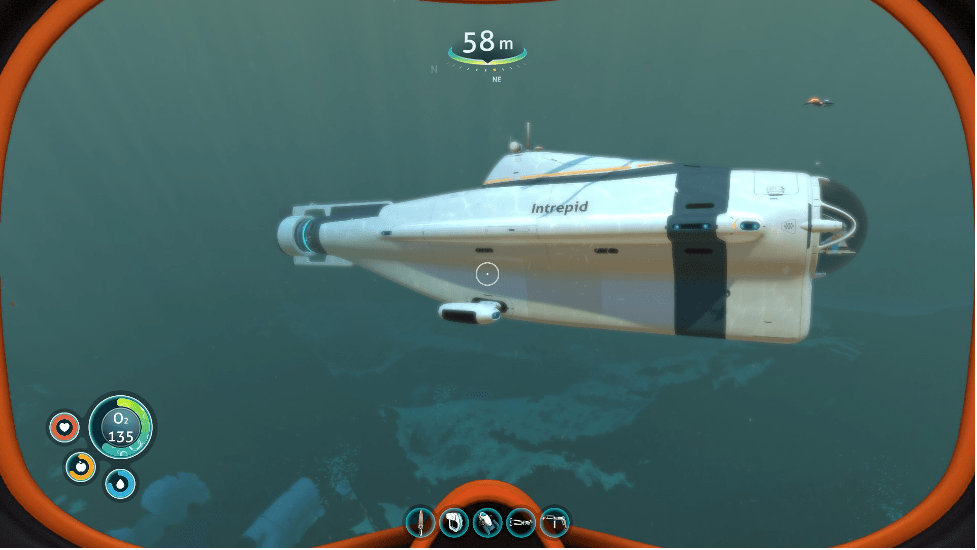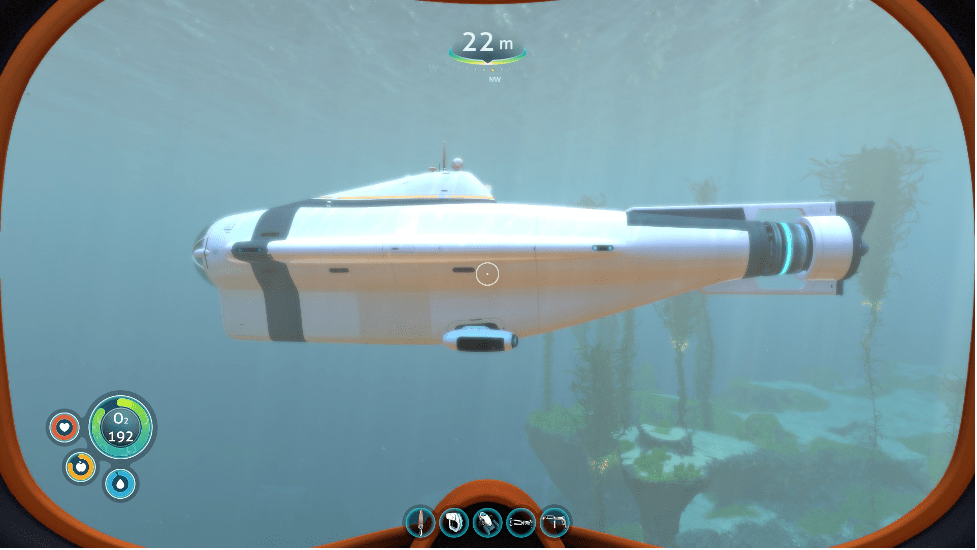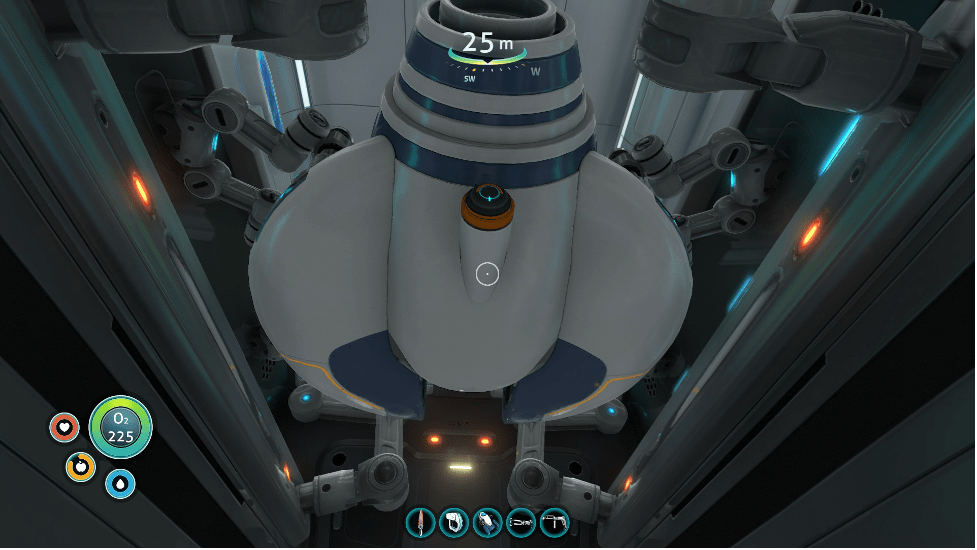
- Last Updated on
Subnautica’s Cyclops is the ultimate vehicular goal for survivors on planet 4546B. It is by far the largest vehicle in Subnautica, easily surpassing the Seamoth and Prawn suit. It also has a vehicle bay and an initial crush depth of 500 meters, making it a perfect mobile base of operations. Presented with a vehicle practically dripping with possibility, the question is obvious – how do you build the Cyclops in Subnautica?
💥 Don't Miss These Latest Deals 💥

- 27 inch QHD (2560*1440) display with the DCI-P3 90% wide color gamut brings what you’re watching to life in over 16.7M colors

- Nvidia ampere streaming multiprocessors
- 2nd generation rt cores:
- 3rd generation tensor cores
Subnautica Cyclops – finding the fragments
In Subnautica, you must scan fragments of damaged bits of machinery in order to unlock blueprints. The Cyclops is no different, requiring three scans of three different components before you can build the submersible. Each component will have fragments dotted about in various areas, so you’ll need to prepare for a bit of exploration. To make things easier, you should build a scanner room and search for components. With the HUD chip equipped, you’ll have no problem finding the fragments assuming your scanner is in range to locate them.
Cyclops bridge fragments
The bridge is possibly the first component for which you will find fragments, as they can spawn near the Aurora crash zone. Bridge fragments also spawn in the Mushroom Forest, in addition to the Sea Treader’s Path. Your best bet for finding these fragments is to build a scanner room near the Mushroom Forest, equip a HUD chip, then set off in search of the fragments. The reason behind this specific location is that fragments for the other components spawn here too, making your search that bit easier. It’s also pretty safe, though there’s something to be said for scurrying about under the nose of a Reaper Leviathan.
Cyclops hull fragments
The locations for this component are fewer than the others, being found only in the Mushroom Forest and along the Sea Treader’s Path. As with the bridge, your best bet is to build a scanner room and follow the signal.
Cyclops engine fragments
There are a bunch of locations in which you can find engine fragments. Firstly, you should do as you did with the others and scan the Mushroom Forest. If you come up short, your next best bet is to search the Aurora itself, specifically the cargo bay and Prawn bay. It can be a little sketchy getting inside, but once aboard, you should be safe from any nasties. Other than that, you should search around the Aurora crash zone, the Mountains area, and the Crag Field. Cyclops engine fragments can also spawn near some wrecks, though that doesn’t seem as reliable as the other methods.
Building the Cyclops

Now that you’ve scanned the fragments and unlocked the blueprints, you have only one more chore ahead, the gathering of materials. These materials aren’t too hard to get, but I’ll break down each component just in case.
Let’s start with the basic items. You’ll need to obtain three bits of lead, one lubricant which can be fabricated from a creepvine seed cluster, and three pieces of enameled glass. If you’re struggling to find Stalker teeth, lay cameras from your scanner room out for the Stalkers to bite, then follow them. Before long, you’ll have your Stalker teeth.
There are a couple of more advanced materials to obtain. First, you’ll need to make three plasteel ingots. Lithium can be a pain to find readily, but the Mountains are your best bet. The last component is an advanced wiring kit. This isn’t hard to make in itself, it just requires a bunch of materials. Use the scanner room if you’re having trouble finding anything. Once you have everything, you can move on to your Mobile Vehicle Bay.
Putting the Cyclops to sea
With all the busy work done, it’s time for the good part. Take your Mobile Vehicle Bay and deploy it in a fairly deep area. Unsurprisingly, the Cyclops needs a bit of wiggle room to be built, and you’ll want an open space for your first dive. For reference, pretty much anywhere other than the Safe Shallows will do. Once you’ve found your spot, deploy the Bay and commission the sub. Enjoy watching the construction of your home away from home.
The Cyclops’ maiden voyage

Though you might be tempted to set off immediately, there are a few things you should know to make your first voyage a safe one. First and foremost, you aren’t invincible. Trying to go hull-to-fin with a Reaper will just make you a glorified fast-food delivery service, with you being the main course. That said, there are ways to defend yourself against the terrors of the deep.
Upgrade modules are one way, which I’ll go over in a later section, and decoys are another. Decoys can be deployed by hitting the torpedo-esque button to the right of the helm. Once launched, they will attract all aggressive fauna nearby, allowing you to slip away. Be sure to load up the decoy tube and pack a few spares before you dive.
If you get caught without decoys, you’ll need to get active. When the Cyclops takes enough damage, the hull will become compromised and fires will start. If you don’t want to be a smoked snack for a leviathan, you’ll need to do some field repairs. Grab your repair tool or fire extinguisher and check the Cyclops’ hologram. It will show you where in the sub you are needed. Rush over there and get repairing. The longer you wait, the more damage you sustain. To reduce the risk of fire spreading and leaks causing massive floods, keep your bulkheads closed. This will split the Cyclops into sections, localizing damage sustained.

In a sticky situation, you might be tempted to throttle up to flanking speed. While acceptable in short doses, this can cause far more issues than it solves. By forcing your propellers into overdrive, you will begin cavitation, meaning your speed is pressurizing the water and making it explode. Not only can this cause damage to your Cyclops, but it’s incredibly noisy and will make anything in your general area very interested in your struggle. Instead, try to break off from your pursuers however you can, even if it means disembarking to fire your stasis rifle.
When you get a bit of separation, activating silent running will make you significantly harder to detect. If disaster strikes and you have to abandon ship, make use of the vehicle bay. If you store a Seamoth inside, you can use it to evacuate while your Cyclops acts as a distraction. It will mean losing it, but at least you keep your life.
Lastly, your Cyclops is a mobile seabase, so treat it as such. You can build quite a few bits and pieces inside using the habitat builder, though it is understandably limited to furniture. Put some storage in the main section, throw down a table and a bed, stock some extra supplies, and you’ll have a comfortable home in no time. With a bit of customization, your Cyclops can be the perfect staging ground for whatever expedition you have in mind.
Upgrading Subnautica’s Cyclops

Though the Cyclops is a big step up from what you previously had access to, it is still quite limited at the start. As with the other vehicles, you can find upgrade modules to improve the capabilities of the Cyclops, tailoring the sub to your style. As with the fragments, a surefire way of finding these is to build a scanner room in their respective areas and focus on databoxes. You’ll find them in no time.
Cyclops decoy tube upgrade
This upgrade is a handy one to have for when you need to fire off a few decoys in quick succession. Once installed, it will increase your tube’s capacity from one decoy to five. With this, you can focus more on evading your pursuers, rather than wasting precious seconds loading up a new decoy. It isn’t the most flashy upgrade, but you’ll find yourself thanking its presence every now and then. You can find it in wrecks in the Grand Reef, Sea Treader’s Path, and the Mountains.
Cyclops depth modules
There are three depth modules for the Cyclops in Subnautica. Unsurprisingly, they increase the maximum crush depth of the sub, from 500 meters to 1700 meters with the third module, so they are pretty important upgrades to get. The first can be found in Lifepod 2, or in wrecks in the Dunes and the Grand Reef. The second and third can be crafted at your modification bench using the previous module as a base, though the materials needed can get expensive.
Cyclops docking bay repair module

This upgrade isn’t terribly useful, only saving you the slight inconvenience of having to manually repair your smaller vehicles. It can be a decent pick if you don’t have anything else, but any other module is more worthwhile than this one. It can be found in wrecks in the Grand Reef, Sea Treader’s Path, and the Mountains.
Cyclops engine efficiency module
The engine efficiency upgrade is particularly useful if you intend to travel a lot with your Cyclops. As it sounds, it cuts down on the power usage of the engine, reducing it by a full 300%. It can be found in the flooded Aurora’s drive room, where you must make repairs. The module is in a console, obtaining it will also unlock its blueprint.
Cyclops fire suppression system
The fire suppression module is an especially useful tool to increase your Cyclops’ survivability. Once installed, it will lower the chance of catching fire, alongside offering a new button that, when pushed, expends 200 energy to extinguish all fires aboard. It will cause all bulkheads to lock for thirty seconds while it does so. You can find this module in wrecks in the Blood Kelp Trench, Sparse Reef, and Underwater Islands.
Cyclops shield generator
The shield generator is the best way to defend the Cyclops from the creatures in Subnautica. With the module installed, it adds the ability to activate a shield, making the Cyclops impervious to any damage, including crush damage. When a creature attacks, it will be repelled, swimming far away before launching another attack. Timed well with flanking speed, you should be able to escape most of what inhabits the depths. The shield does cost about ten energy per second though, so use it sparingly. It can be found in wrecks in the Dunes and the Sea Treader’s Path, alongside in a particular story location. I won’t specify for the sake of spoilers, but keep an eye out and you’ll find it without issues.
Cyclops sonar upgrade

The sonar is another incredibly useful upgrade to the Cyclops. It enables you to map your surroundings periodically by means of sonar pulses, which is pretty much mandatory in the darkest depths of Subnautica. You can find it in wrecks in the Blood Kelp Trench, Bulb Zone, and the Grand Reef.
Cyclops thermal reactor module
The thermal reactor is the final upgrade to the Cyclops, one which is critically important if you intend to use the sub as a self-sufficient mobile base. It only works when in temperatures of 35C or more, charging the power cells plugged into your bank. You can find it in wrecks in the Grand Reef, Mountains, and the Mushroom Forest.
That’s everything you need to know about the Cyclops in Subnautica. With it built and equipped, you’ll be well-positioned to tackle the later stages of the game, especially with some upgrades installed. If you’re looking for a good combo, depth 3, the shield generator, sonar, and thermal reactor make for a pretty good mobile base with defensive capabilities. The other two slots are down to personal preference, but I’d make a strong argument for the engine efficiency module, as you get more from your power cells. However you choose to suit up your Cyclops, good luck in the depths.
Frequently Asked Questions
Can The Cyclops Be Destroyed Subnautica?
This player-controlled submarine is the ultimate vehicular goal for many survivors on the planet. This submarine boasts a pretty damn tough exterior that seems to resist damage to most of the underwater animals you encounter. With such high damage mitigation, is it possible to destroy the cyclops in Subnautica?
Although most underwater fauna cannot do any significant damage to the cyclops, and although Bonesharks and Stalkers can attempt to attack it, it’s unlikely to cause damage. However, there are a few ways to destroy it.
You can bring your cyclops to a 300-meter depth, drive it against a wall, and let it sink – although this can be a bit of a gamble. Alternatively, you can take your pressure compensator out and sink your cyclops past crush depth to destroy it.
Although repairs can do damage to your cyclops, they can’t destroy it. However, they can take away as much as 50% health.
How Big Is The Subnautica Map?
Horizontally, the Subnautica map is approximately 2.5km x 2.5km. The map is roughly 4000 meters across and 1500 meters down – in other words, it’s pretty big!
Although the Subnautica world does have a limit, you’ll have to cover an extremely large area before you reach it. The entire game is set within a large crater, and the areas beyond it, such as The Void, Deep Zone, Dead Zone, and Crater’s Edge, can feel like they go on indefinitely. You’ll discover many biomes, resources, wrecks, lifepods, and more before you come close to the end of the map. Some pretty cool adventures await you!
Contrary to popular belief, Subnautica map is unlike some Minecraft maps that continuously regenerate without an end. However, the map is notoriously large, and some areas, such as The World Edge Biome, can go as deep as 8192 meters – pretty impressive, right?
Is Subnautica Free On PC?
Subnautica is such an exhilarating survival horror game that it’s well worth everyone playing, so can you get it for free? Well, you used to be able to.
Back in December 2018, Epic Games teamed up with Subnautica’s developer/publisher, Unknown Worlds, to offer Subnautica for free on the Epic Games Store. They offered this great deal to draw new customers to their store.
All gamers had to do was log into their Epic Games Store account, or simply create a new one. After that, they could download the game for free. Unfortunately, this was only a temporary offer, and it ended just before midnight of December 27th 2018. It hasn’t been offered again since!
However, you can still buy Subnautica for PC at its regular price. You can do this from a range of places, such as the Epic Games Store or Steam. It isn’t actually too expensive, either!
Which Subnautica Should I Play First?
This decision will generally fall to your personal preference and playstyle when it comes to survival-horror and resource management games.
If you are a big fan of underwater games and exploration in general, you’re going to love both of these games anyway, especially if you are someone that can’t turn away from the creeping terror that you know lies in the depths, but cannot see to defend yourself against.
Creeping horror aside, there are some elements from the first game, Subnautica, that do carry over to the sequel, Below Zero, such as some lose plot points as to why you are on the planet in the first place, and why you are in a subarctic setting.
However, the plots of these games are not at the forefront of their story, as you will spend the vast majority of your time simply swimming and exploring.
In short, play these in any order!


























